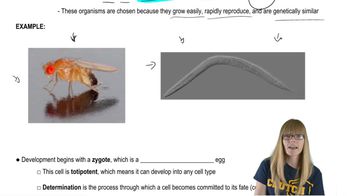In an inheritance case, a man has died leaving his estate to be divided equally between 'his wife and his offspring.' His wife (M) has an adult daughter (D), and they argue that they should split the estate equally. As a young couple, however, the man and his wife had a son that they gave up for adoption. Two men have appeared, each claiming to be the son of the couple and therefore entitled to a one-third share of the estate. The accompanying illustration shows the results of DNA analysis for five genes for the mother (M), her daughter (D), and the two claimants (S1 and S2). How many nonmaternal DNA bands are shared by D and S1? By D and S2?
Table of contents
- 1. Introduction to Genetics51m
- 2. Mendel's Laws of Inheritance3h 37m
- 3. Extensions to Mendelian Inheritance2h 41m
- 4. Genetic Mapping and Linkage2h 28m
- 5. Genetics of Bacteria and Viruses1h 21m
- 6. Chromosomal Variation1h 48m
- 7. DNA and Chromosome Structure56m
- 8. DNA Replication1h 10m
- 9. Mitosis and Meiosis1h 34m
- 10. Transcription1h 0m
- 11. Translation58m
- 12. Gene Regulation in Prokaryotes1h 19m
- 13. Gene Regulation in Eukaryotes44m
- 14. Genetic Control of Development44m
- 15. Genomes and Genomics1h 50m
- 16. Transposable Elements47m
- 17. Mutation, Repair, and Recombination1h 6m
- 18. Molecular Genetic Tools19m
- 19. Cancer Genetics29m
- 20. Quantitative Genetics1h 26m
- 21. Population Genetics50m
- 22. Evolutionary Genetics29m
18. Molecular Genetic Tools
Methods for Analyzing DNA
Problem 12
Textbook Question
What is the main purpose of genome-wide association studies (GWAS)? How can information from GWAS be used to inform scientists and physicians about genetic diseases?
 Verified step by step guidance
Verified step by step guidance1
Understand the purpose of GWAS: Genome-wide association studies (GWAS) aim to identify genetic variants across the genome that are associated with specific traits or diseases. This is achieved by analyzing large datasets of genetic information from individuals with and without the trait or disease.
Learn how GWAS works: GWAS involves scanning the genome for single nucleotide polymorphisms (SNPs) and other genetic markers. Statistical methods are used to determine whether certain genetic variants are significantly associated with the trait or disease being studied.
Interpret the results: Once genetic variants are identified, researchers can pinpoint regions of the genome that may contribute to the development of the disease or trait. These regions often contain genes or regulatory elements that play a role in biological processes.
Apply findings to medical research: Information from GWAS can help scientists understand the genetic basis of diseases, identify potential drug targets, and develop personalized medicine approaches. Physicians can use this data to assess genetic risk factors in patients and guide prevention or treatment strategies.
Consider limitations and future directions: GWAS results often require further validation and functional studies to confirm the role of identified genetic variants. Additionally, GWAS may not capture rare variants or complex interactions between genes and environmental factors, which are important for understanding genetic diseases comprehensively.
 Verified video answer for a similar problem:
Verified video answer for a similar problem:This video solution was recommended by our tutors as helpful for the problem above
Video duration:
1mPlay a video:
Was this helpful?
Key Concepts
Here are the essential concepts you must grasp in order to answer the question correctly.
Genome-Wide Association Studies (GWAS)
GWAS are research methods used to identify genetic variants associated with specific diseases by scanning the genomes of many individuals. They compare the DNA of individuals with a particular condition to those without, looking for common genetic markers. This approach helps in understanding the genetic basis of diseases and can reveal potential targets for treatment.
Recommended video:
Guided course

Genetics of Development
Single Nucleotide Polymorphisms (SNPs)
SNPs are the most common type of genetic variation among people, where a single nucleotide in the genome differs between individuals. In GWAS, researchers often focus on SNPs to find associations with diseases. Identifying these variations can help in understanding how genetic differences contribute to disease susceptibility and progression.
Recommended video:
Guided course

Recombination after Single Strand Breaks
Translational Medicine
Translational medicine is the process of applying findings from basic science to enhance human health and disease treatment. Information from GWAS can inform scientists and physicians about genetic predispositions to diseases, leading to personalized medicine approaches. This can improve diagnosis, prevention strategies, and the development of targeted therapies based on an individual's genetic profile.
Recommended video:
Guided course

Translation initiation

 7:40m
7:40mWatch next
Master Methods for Analyzing DNA and RNA with a bite sized video explanation from Kylia
Start learningRelated Videos
Related Practice
Textbook Question
466
views
